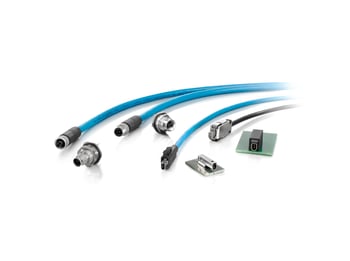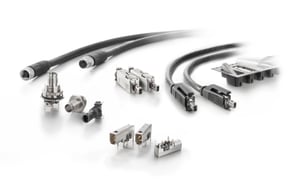Single-pair Ethernet is the technology that makes it possible to implement the Internet of Things consistently within industry, right through to field-based applications. Simon Seereiner, Head of Product Management SAI & IE at Weidmüller, explains how it works and what still needs to be done before this technology can achieve widespread adoption in industrial applications.
Single-Pair Ethernet (SPE) technology is poised to transform the Industrial Internet of Things (IIoT). These connectors, which enable power and data to flow in both directions through one single twisted pair of wires, offer a path to simplified, faster, and more powerful industrial architectures. Significant reductions in size, weight, cable volume, and time required to install systems can be achieved with SPE, without sacrificing performance: SPE can transmit up to 1G/ps and 60W of power in a form factor that is 50% smaller than an RJ45 connector. The standard awaits finalization, but in the meantime, system designers can begin to explore the potential SPE presents to designers of IIoT architectures.
Why is SPE technology becoming increasingly important in communication architecture in the industrial sector?
We now use IP-based communication pretty much everywhere — in smartphones and on our computers but also in industrial facilities. Over the last 20 years, we have seen more and more Ethernet-based communication architectures being implemented in industrial applications, such as Profinet, Ethernet IP, and Ethercat. All of these are Ethernet-based field-bus systems. However, there is a lack of consistency right at the last hurdle, i.e. at the sensor-actuator level. At this level, we are still using bus architectures such as Profibus, CAN, and ASI. This means that there are gateways that convert the Ethernet-based communication. Today’s approach is to achieve consistent communication so that IP-based communication can be implemented even at the very lowest sensor-actuator level.
Why is there not yet any Ethernet-based communication at the sensor-actuator level?
 Previously, it was simply too expensive and too complicated to extend Ethernet-based networks all the way to sensor level. But this has now changed, thanks to single-pair ethernet.
Previously, it was simply too expensive and too complicated to extend Ethernet-based networks all the way to sensor level. But this has now changed, thanks to single-pair ethernet.
Weidmüller’s range of SPE connector and cabling products provide powerful and simplified solutions for industrial architectures.
Could you explain exactly what this SPE technology does?
For a while now, engineers have been aware that fast Ethernet, this is, with a 100MB cable, requires at least two pairs of wires, with a gigabit cable requiring four pairs. With SPE technology, only one pair of wires is needed for the same transfer rates, meaning that only a quarter of the amount of copper is required, as well as only a quarter of the processing time. This not only saves space, but also a huge amount of money.
So data transmission can be carried out in a more compact space and in a more cost-effective manner?
Yes, but this doesn't just apply to data transmission. A key benefit of this technology is the fact that both data and power can be transferred via these two-wire cables. This is based on a technology called power over data line (PoDL) which makes it possible to guide up to 60W to an interface during simultaneous data transmission (100Mb/s). Sensor systems, for example, can therefore be supplied with just one two-wire cable. As a result, sensor systems can be easily and cheaply set up in industrial applications with a high density, which in turn helps to increase levels of automation and networking while also implementing processes with an ever-increasing degree of automation.
You say the whole process is more cost-effective. Do you have any evidence for this?
Because the infrastructure doesn't yet exist, we aren't yet able to use this technology. However, we have done simulations and theoretical observations in the tool construction and machinery manufacturing industries. We have also consulted experts from the machinery and plant engineering sector, with whom we have been discussing the question: "Lets imagine that SPE is available. What would you do differently? Where would you cut costs and what would be the impact of simplifying the processes?”
The results were very impressive. The technology obviously helps save component costs, but a much greater advantage is the fact that machinery can be controlled and operated much more efficiently and with a transparent architecture. This saves a huge amount of money in parameterization, as well as during commissioning and when carrying out work. In the simulations we carried out, operating costs were reduced by 18% when using SPE technology.
What conditions need to be met in order for SPE to be used across the board?
First, the infrastructure needs to be fully established. Only when cables, plug-in connectors, chipsets, switches, and devices are able to speak the same  Ethernet-based SPE language will it be possible for major automation service providers to set up their associated control systems and device functionalities. We, meaning companies in the electrical connectivity sector, are essentially at the epicenter of this new phase, and will be the ones taking the first steps required to establish a new technology.
Ethernet-based SPE language will it be possible for major automation service providers to set up their associated control systems and device functionalities. We, meaning companies in the electrical connectivity sector, are essentially at the epicenter of this new phase, and will be the ones taking the first steps required to establish a new technology.
Is the market ready to implement a new technology?
There’s a great deal of interest on the market. I could talk to customers about this issue virtually every day. But a new technology is always adopted gradually, and we’re still right at the start of the process. Hype is definitely growing, but we are not expecting to sell thousands of our SPE plug-in connectors in the next year. As a pioneer in the field of electrical connectivity, it is important to us to launch our products on the market at the right time so that they can be put to use and trialed by our customers
You have already developed SPE plug-in connectors. To what extent is Weidmüller getting involved in SPE technology?
We are active in two different fields. First, we have brought the series products mentioned earlier to the market for internationally standardized interfaces as per IEC 63171-2 and IEC 63171-5. There are now four companies that have independently created tools for these interfaces, allowing Weidmüller to work with partners to bring products to the market and build up a plug-in-connector infrastructure.
Second, Weidmüller is heavily involved in standardization. I myself am a member of the Profibus user organization (PNO) and the Open Devicenet Vendors Association (ODVA). We also have employees in the IEC plug-in connector committee and are members of the Institute of Electrical and Electronics Engineers (IEEE) standards association. We are therefore using our specialist expertise in the area of standardization for cables and plug-in connectors to help implement the correct standards.
Talking of standards – what’s the current situation in this respect?
There is a very high level of interest in standards across all industries, and the standardization process is well underway. Naturally, at this stage of the process, some manufacturers tend to communicate proposals as regulations without further ado in order to issue their product as a new standard. The normative process is currently underway but has not yet been completed. The claim that the market had already agreed upon a mating face, as was made by some manufacturers and is often mentioned in the trade press, is categorically incorrect. Important and powerful user organizations such as PROFINET are currently forming their own opinion and will deal with this subject area in the future.
Let’s end by looking to the future: Will SPE technology still exist in 20 years, or will contactless data transmission be the standard technology in industrial applications?
I’m positive that there will still be a lot of SPE interfaces in 20 years. But contactless transmission is a really interesting topic. Wireless applications are already being used in the industrial sector today, such as in high-bay warehouses, although we estimate that wireless applications make up just 2% to 3% of electrical connectivity applications. This will undoubtedly increase, although cabled transmission sections will continue to exist in the future. These sections will just be much more compact and will be capable of transmitting higher frequencies. As a key component of the future infrastructure for industrial IoT, SPE will be the starting point for this new direction.

